It's classical schematic from the middle of 1980s. Scheme was took from here AIKIDO - Low-volage with buffer version
I don't know, who invented it, but using tube-preamp with solid state-out topology so strange, I guess... Anyway I decided to assemble this schematic, of cause without tube's preamp, for fun.
550C+560C may changed on 850C+860C NXP, ON Semi/Fairchild. In output I'm recommending to use MJE15034G+MJE15035G, or MJE243G+MJE253G instead crappy BD139+140 (doesn't matter ON Semi, NXP or NoName, cause their place in Power Supply only). PCB was made with standard "Star" topology and don't has any problems with hum, buzz or another crap.
DC offset doesn't exceed 30 mV (1st channel 1 mV float±2 mV, 2nd channel 25 mV and float ±3 mV). Bias 80 mA±2 mA (1st channel 78 mA, 2nd channel 82 mA and float ±2mA on two channels). One of the channels had problems on 50 kHz square signal caused by "broken" 1N4148.
The sound likes me a little more, than Lehmann BCL's Diamond Buffer (deeper sound scene, more details on the trebles and a little more aggressive bass).
p/s. It's only test assembling for fun. I like Diamond Buffer's schematics. It's a classic like Group B. I'm not recommending this scheme to amateurs, if you want DB, better start from Lehmann Black Cube Linear schematic or something passed test of time.
I don't know, who invented it, but using tube-preamp with solid state-out topology so strange, I guess... Anyway I decided to assemble this schematic, of cause without tube's preamp, for fun.
550C+560C may changed on 850C+860C NXP, ON Semi/Fairchild. In output I'm recommending to use MJE15034G+MJE15035G, or MJE243G+MJE253G instead crappy BD139+140 (doesn't matter ON Semi, NXP or NoName, cause their place in Power Supply only). PCB was made with standard "Star" topology and don't has any problems with hum, buzz or another crap.
DC offset doesn't exceed 30 mV (1st channel 1 mV float±2 mV, 2nd channel 25 mV and float ±3 mV). Bias 80 mA±2 mA (1st channel 78 mA, 2nd channel 82 mA and float ±2mA on two channels). One of the channels had problems on 50 kHz square signal caused by "broken" 1N4148.
The sound likes me a little more, than Lehmann BCL's Diamond Buffer (deeper sound scene, more details on the trebles and a little more aggressive bass).
p/s. It's only test assembling for fun. I like Diamond Buffer's schematics. It's a classic like Group B. I'm not recommending this scheme to amateurs, if you want DB, better start from Lehmann Black Cube Linear schematic or something passed test of time.
Attachments
-
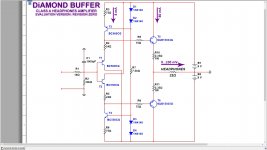 Diamond Buffer Class A HPA.jpg239.9 KB · Views: 1,066
Diamond Buffer Class A HPA.jpg239.9 KB · Views: 1,066 -
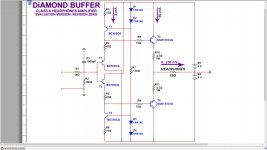 Diamond Buffer Class A HPA v2.jpg239.8 KB · Views: 1,077
Diamond Buffer Class A HPA v2.jpg239.8 KB · Views: 1,077 -
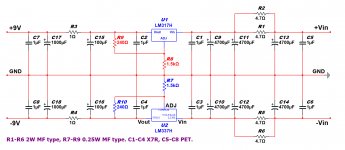 HPA PS.jpg287 KB · Views: 932
HPA PS.jpg287 KB · Views: 932 -
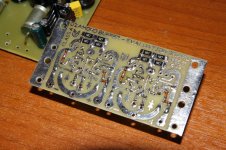 DB HPA_SM_002.jpg295.5 KB · Views: 830
DB HPA_SM_002.jpg295.5 KB · Views: 830 -
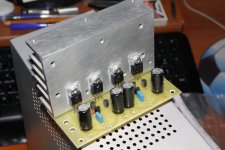 DB HPA_SM_003.JPG806.1 KB · Views: 737
DB HPA_SM_003.JPG806.1 KB · Views: 737 -
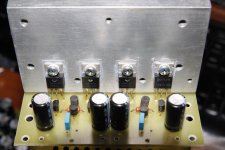 DB HPA_SM_004.JPG827.8 KB · Views: 429
DB HPA_SM_004.JPG827.8 KB · Views: 429 -
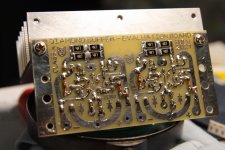 DB HPA_SM_006.JPG914.3 KB · Views: 642
DB HPA_SM_006.JPG914.3 KB · Views: 642
Last edited:
Hello Daman, what you are showing here is indeed the diamond buffer, biased pretty hot -
In the current feedback op amp world, this is what we call the base input Class AB buffer - and is essentially what is in the BUF634A.
Another version we use is to make those input transistors just diodes up and down, still get the Class AB biasing to the output stick, but you get much lower voltage noise, but higher current noise - this is what is in the TPA6120A input stage (which is actually a THS6012 dual ADSL line driver die)
In the current feedback op amp world, this is what we call the base input Class AB buffer - and is essentially what is in the BUF634A.
Another version we use is to make those input transistors just diodes up and down, still get the Class AB biasing to the output stick, but you get much lower voltage noise, but higher current noise - this is what is in the TPA6120A input stage (which is actually a THS6012 dual ADSL line driver die)
Incidentally, I think the diamond buffer name might be quite old, but I recall seeing it mainly in some BurrBrown German design center video parts like the old OPA660 (still available as the OPA860). We always called it a Class AB buffer at Comlinear and BurrBrown Tucson and comprised a very important block in every current feedback input stage.
Hello Daman, what you are showing here is indeed the diamond buffer, biased pretty hot -
In the current feedback op amp world, this is what we call the base input Class AB buffer - and is essentially what is in the BUF634A.
Another version we use is to make those input transistors just diodes up and down, still get the Class AB biasing to the output stick, but you get much lower voltage noise, but higher current noise - this is what is in the TPA6120A input stage (which is actually a THS6012 dual ADSL line driver die)
Thanx for info, but I did find it (about BUF634 - I guess it's a discrete version of him).
Yep, all started from Hewlett Packard.
Anyway the amplifier is working without troubles.
....the diamond buffer name might be quite old....
Applications of Wide-Band Buffer Amplifiers (on TI site, 0.5MB PDF)
National Semiconductor Application Note 227
October 1, 1979
Has a description of the LH0002 circuit which is a basic Diamond Buffer, though not by name.
Be clear on two variants. If you pick the input current generously and pick the output devices much larger than the input devices it "naturally" works in Class A up to usefully high current. You can then go further into class B, and get high current, but typically a glitch coming back to idle.
I myself have done quite a number of buffers - starting with the closed loop CLC110 (where we got a patent) and then on to the BUF602, also closed loop - which of course has a lot of linearity advantages. The most useful closed loop buffer is the one we put into the OPA684 input stage, only closed loop input stage CFA (and OPA683) which gives almost perfect fixed BW vs gain.
PCB in Sprint-Layout 6 format
File contains following PCB: current HPA Class A Diamond Buffer based, Lehmann Black Cube Linear Clone (3 versions: current buffer only, AD825+CB, AD817ANZ+CB), power supply on LM317+LM337, simple DC protection.
File contains following PCB: current HPA Class A Diamond Buffer based, Lehmann Black Cube Linear Clone (3 versions: current buffer only, AD825+CB, AD817ANZ+CB), power supply on LM317+LM337, simple DC protection.
Attachments
The LH0002 has a total bias current of 6mA.
It also has a relatively high input offset voltage, and high input bias current.
The LH0033 is FET input, and can be configured as a Sziklai with additional devices for much higher bias.
XEN ZGF Portable Headphone Amplifier
I built a version of the Jung buffer 8 years ago :
SMD High-Voltage Discrete Diamond Buffer
Measures quite well.
But for low impedance headphones, I want something with lots of bias for pure class A.
And preferrably with FET input.
Also I do not like using a PNP to compensate for non-linearities in an NPN, or vice vera.
They are never 100.000% the same.
This one can be biased up to 500mA with suitable heatsink.
Will drive speakers at easy, in a NFB loop with an opamp.
And you can go to +/-24V with an OPA604 or similar.
The XEN XELF Headphone Buffer
Cheers,
Patrick
It also has a relatively high input offset voltage, and high input bias current.
The LH0033 is FET input, and can be configured as a Sziklai with additional devices for much higher bias.
XEN ZGF Portable Headphone Amplifier
I built a version of the Jung buffer 8 years ago :
SMD High-Voltage Discrete Diamond Buffer
Measures quite well.
But for low impedance headphones, I want something with lots of bias for pure class A.
And preferrably with FET input.
Also I do not like using a PNP to compensate for non-linearities in an NPN, or vice vera.
They are never 100.000% the same.
This one can be biased up to 500mA with suitable heatsink.
Will drive speakers at easy, in a NFB loop with an opamp.
And you can go to +/-24V with an OPA604 or similar.
The XEN XELF Headphone Buffer
Cheers,
Patrick
Hi Patrick,
I like the idea a lot, but I am not knowledgeable enough to determine whether the concept could be extended to provide higher power by using different external devices, e.g., 2SA1943/2SC5200, MJL3281/MJL1302, LatFET or the like. Or, is there any issue that I am not aware of?
Kindest regards,
M
I have discovered lots of both LH0002 and LH0033, and doing some search on their usability, I discovered your above mentioned amplifier.The LH0002 has a total bias current of 6mA.
It also has a relatively high input offset voltage, and high input bias current.
The LH0033 is FET input, and can be configured as a Sziklai with additional devices for much higher bias.
XEN ZGF Portable Headphone Amplifier
I like the idea a lot, but I am not knowledgeable enough to determine whether the concept could be extended to provide higher power by using different external devices, e.g., 2SA1943/2SC5200, MJL3281/MJL1302, LatFET or the like. Or, is there any issue that I am not aware of?
Kindest regards,
M
I have not tried, but you can take a look at this, where the Sziklai originates from :
https://www.diyaudio.com/community/...rlington-in-feedback-loop.296331/post-4823351
Also a published schematics here based on a discrete LH0033 :
https://www.diyaudio.com/community/threads/dc-adjustable-double-sziklai-power-diamond-buffer.59952/
Patrick
https://www.diyaudio.com/community/...rlington-in-feedback-loop.296331/post-4823351
Also a published schematics here based on a discrete LH0033 :
https://www.diyaudio.com/community/threads/dc-adjustable-double-sziklai-power-diamond-buffer.59952/
Patrick
- Home
- Amplifiers
- Headphone Systems
- Simple Headphones Amplifier on Diamond Buffer based